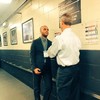Photo by Larry W. Smith/EPA-EFE
It’s been a little over two weeks since Sacramento Kings head coach Dave Joerger had this to say about everyone’s favorite wunderkind, Luka Doncic: “Perhaps there was an idea that there was a ceiling on him. I don't see it, unfortunately for us.” The statement was received as a searing subtweet aimed towards Kings assistant general manager Brandon Williams. Maybe it was, maybe it wasn’t. But more important, to me, was what it summoned: an interesting and ever-relevant debate about fit and context pertaining to prospects and the teams that draft them. Generally speaking, it’s silly to pass over a generational talent because he’d be limited in your system or on your roster. If that’s how you feel, change your system and/or your roster.Doncic is good enough to transcend any environment he occupies, but like every other player on Earth, he’s also influenced by what his teammates can/can’t do, and his hypothetical role in Sacramento, next to a blurry pick-and-roll roadrunner like De’Aaron Fox, is different than his actual reality in Dallas. That’s OK. But it’s also fair and natural to consider how Doncic’s game might be limited there. Based on everything we’ve seen, Doncic, Fox, and the Kings would be perfectly fine, but it’d also rob us (and Doncic?) of maximizing the most exciting and beneficial area of his skill-set.Doncic doesn’t need the ball in his hands to positively impact a game, but like so many great playmakers before him, it makes sense to let him influence a majority of his team’s on-court decisions. Before Dennis Smith Jr.’s return, we witnessed a few lineups that let Doncic literally stand alone as his team’s point guard. No J.J. Barea, DSJ, Devin Harris, or Jalen Brunson. When Dallas is healthy those lineups won’t see the floor, and there’s been mixed results in the limited time we saw them play, but those minutes offered a glimpse towards how the Mavs may want to build around their franchise player.(I absolutely love DSJ and am not one to give up on the compatibility of any two players as young and talented as him and Doncic, but—an uptick in three-point shooting aside—nobody should be surprised if/when Dallas makes a trade; the Mavericks score 110.9 points per 100 possessions when Doncic is on the floor without Smith Jr. and 100 points per 100 possessions when they both play.)Even though Doncic’s usage rate and True Shooting percentage are actually higher with Smith Jr. on the court than without, just look at the cool stuff he can do when operating in space beside teammates who naturally complement his profound ability to make the defense feel like it’s hallucinating.Everything falls into place when Doncic is surrounded by wings and bigs who provide enough space and defensive versatility. They unlock his best attributes and will eventually let Dallas discover its best self. There are parallels here to how Brett Brown decided to use Ben Simmons last year (a move that wasn’t obvious at the time). Doncic’s skill-set gives a much longer rope and no pressure to go all-in down one road, but there’s a future where his assist rate is consistently over 35 percent on a top-five offense. (Right now he’s one of six 19-year-old rookies in league history to assist at least 25 percent of his team’s baskets while logging over 1,000 total minutes.)Related: The Mavericks shouldn’t be shy about throwing a lot of money at Malcolm Brogdon this summer. He’s a low-usage cog who can defend point guards while quietly posting 50/40/90 splits. The perfect partner for someone like Doncic once the Mavs start putting the ball in his hands way more than they already are.
Advertisement
